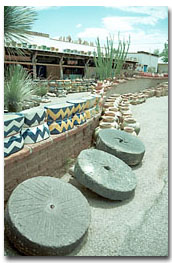By
Michelle McCollum
Arizona Summer Wildcat
"Art meets history" in this tiny western colony
The summers are lazy in Tubac, where artists dream up new creations and visitors stroll the sweltering old-town streets to soak in the creative ambience.
Forty-five miles south of Tucson, Tubac is located just off I-19 at either exit 40 or 34. There, the old dirt roads of the town lead to eighty unique knick-knack and art shops, many of which are run by the artists themselves.
The Lee Blackwell studio, which specializes in copper and metal sculptures and fountains, is run by Blackwell - the designer - with the help of numerous craftsmen who help with the construction of the sculptures.
Janet Hart, a craftsman who's been at the studio for 10 years, describes life in Tubac as quiet, especially in the summer.
"It's a great time for students to come down and learn how all this stuff is done," Hart says. "Hardly any tourists come, so we can take you back and show you the machines and the studios. It is perfect for anyone interested in art of history."
Tubac prides itself in being the "town where art and history meet," because not only is it famous for its well-known artists, it is important in the history of the state of Arizona.
The town was founded in the late 1600's by a Spanish Jesuit who also founded nearby Tumacacori. Tubac has become the oldest European settlement in the entire state. Though, it should be noted, before European settlement, American Indians had inhabited the area for over 10,000 years.
"When the Europeans came, they were surprised the natives were doing as well as they were without European technology," said Dick Sheehan, a volunteer at the Tubac Historical Park. "The natives were farmers and herders, and many of them got converted when the Spanish came in."
A one-room schoolhouse, which was in use until 1965, and a quaint Catholic Church grace the small area of the historical park, while the Anza trailhead leads a five-mile trek to nearby Tumcacaori.

|
|
RANDY METCALF/Arizona Summer Wildcat
|
|
|
When hunger strikes, the town has its share of restaurants from lunch cafes like Cafˇ Fiesta, to serious Mexican dining at Tosh's to sugary sweets at The Chile Pepper.
While the town itself may not yield explosive adventuresome legends like many of its other western counterparts, it does have its own modern charm by housing some of Arizona's prominent native artists, like Hal Empie, a local artist who has been painting the Southwest for over 80 years.
Born in 1909, before Arizona was even a state, Empie says he can't remember when he began to paint, but he remembers he sold his first commissioned painting to a bar owner for $25.
"The man turns to me and he says, 'Do I look like a millionaire to you?" Empie recalls vividly. "You see, $25 was a lot of money then."
Now, many of Empie's works go for $25,000.
While Empie is now blind and must paint at a side angle looking through peripheral vision and must combine colors only through memory, he still paints every day.
"I don't remember when I started painting," Empie says. "I just always have been. Just a part of me like breathing or eating. And I never painted anything from a photograph. I don't know how that even qualifies as original art. Everything is from inside my head."
Many of Tubac's artists, including Empie - who came to Tubac in 1986 - personally sell their work and are happy to talk to any interested fan about their works, their lives, and their inspirations.
"Just walk in and ask questions," Hart says. "Everyone's talkative enough to help you out."